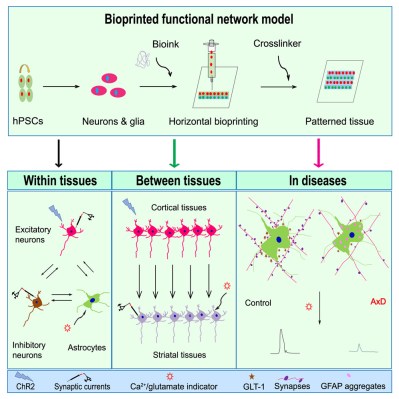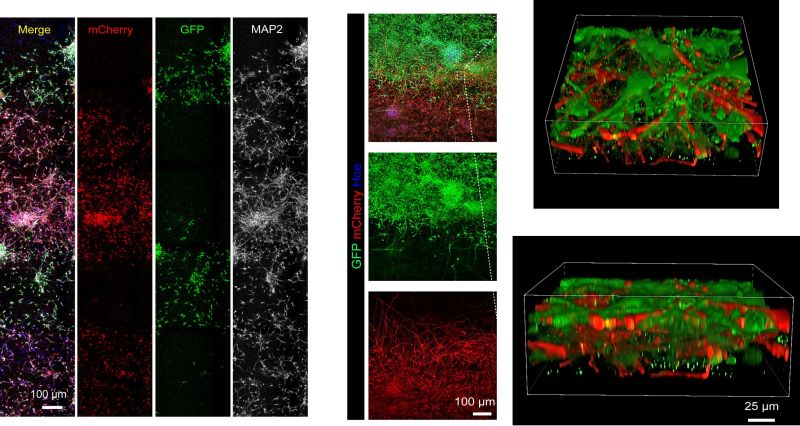
The brain is probably the least explored organ, much of which is due to the difficulty of studying it in situ rather than in slices under a microscope. Even growing small organoids out of neurons provide few clues, as this is not how brain tissue is normally organized. A possible breakthrough may have been found here by a group of researchers whose article in Cell Stem Cell details how they created functional human neural tissues using a commercial 3D bioprinter.
As detailed by [Yuanwei Yan] and colleagues in their research article, the issue with previous approaches was that although these would print layers of neurons, they would fail to integrate as in the brain. In the brain’s tissues, we see a wide variety of neurons and supportive cells, all of which integrate in a specific way to form functioning neuron-to-neuron and neuron-to-glial connections with expected neural activity. The accomplishment of this research team is 3D bioprinting of neural tissues with the necessary functional connections.
Core changes to the process were the use of a fibrin hydrogel, consisting primarily of fibrinogen and thrombin with hyaluronic acid mixed in to decrease the viscosity, along with printing the layers horizontally rather than the previous vertical approach. With this biocompatible support structure in place, the human pluripotent stem cells (hPSCs) in the bioink displayed clear neurite growth and synaptogenesis as they differentiated into specialized cell types and formed neural tissue reminiscent of that seen in the human brain.
Although the researchers admit that this printing approach has many limitations, it nevertheless should provide many advantages for research into the functioning of many parts of our brains and various pathologies that can afflict it.
Bioprinting more mundane organs is a hot topic lately. You might even print your next liver.
















Because what could possibly go wrong.
Oh nothing much.
https://youtu.be/MJmBgKt4nKU
When can we expect a home version printer? I have a dog that needs some brain cells…
Dog? I need it for me.
I think dogs would like to have opposable thumbs first.
If a creature had opposable thumbs AND could lick itself, it would never leave the house.
“The brain is probably the least explored organ,..” Citation? Neuroscience is one of THE leading scientific research areas.
Seriously.
.
The number of rat brains placed under a microscope list number in the billions by now. And there is no shortage of dead from other stuff people brains that have had everything imaginable done to them. There is even this whole field of medicine called Pathology that is dedicated to, among other things, putting slices of all manner of things under a microscope, studying them biochemically, and alllll kinds of cool shiz
Physical brain versus philosophy…
Or DC vs RF..
Maybe they mean they can’t get past the first knuckle.
Define ‘explored’?
If % reasonably understood, then clearly true.
Do they taste just like real brains?
Imagine if you could have an organoid grown from your own stem cells then programmed with the entirety of some future AI model that is just below sentience in its capabilities, and that organ was added to your brain like a peripheral or additional sense. A bit like how old CPUs would use and external FPU for complex math. I’d rather than than being a wirehead connected to somebody else’s AI system.
This will only lead to a brain race. Which country can print the biggest brain. And when they get too big and start to flap about on the floor it will be brains in space (said in the style of the Muppets “Pigs in space”).
Hate to see what a “brain drain” would be like.
Cool. I had my internship at Cellink (the company that made the hardware this is printed on) a couple of years ago. Brings back memories. :-)
When the first small cluster of neurons were hooked up to an old Speak & Spell, this was heard (just a sample): “We hold these truths to be self-evident. All men and women are created, by the, you know, you know the thing.” “The beer brewed here, it is used to make the brew beered here.” “America is a nation that can be defined in a single word: Asufutimaehaehfutbw.”